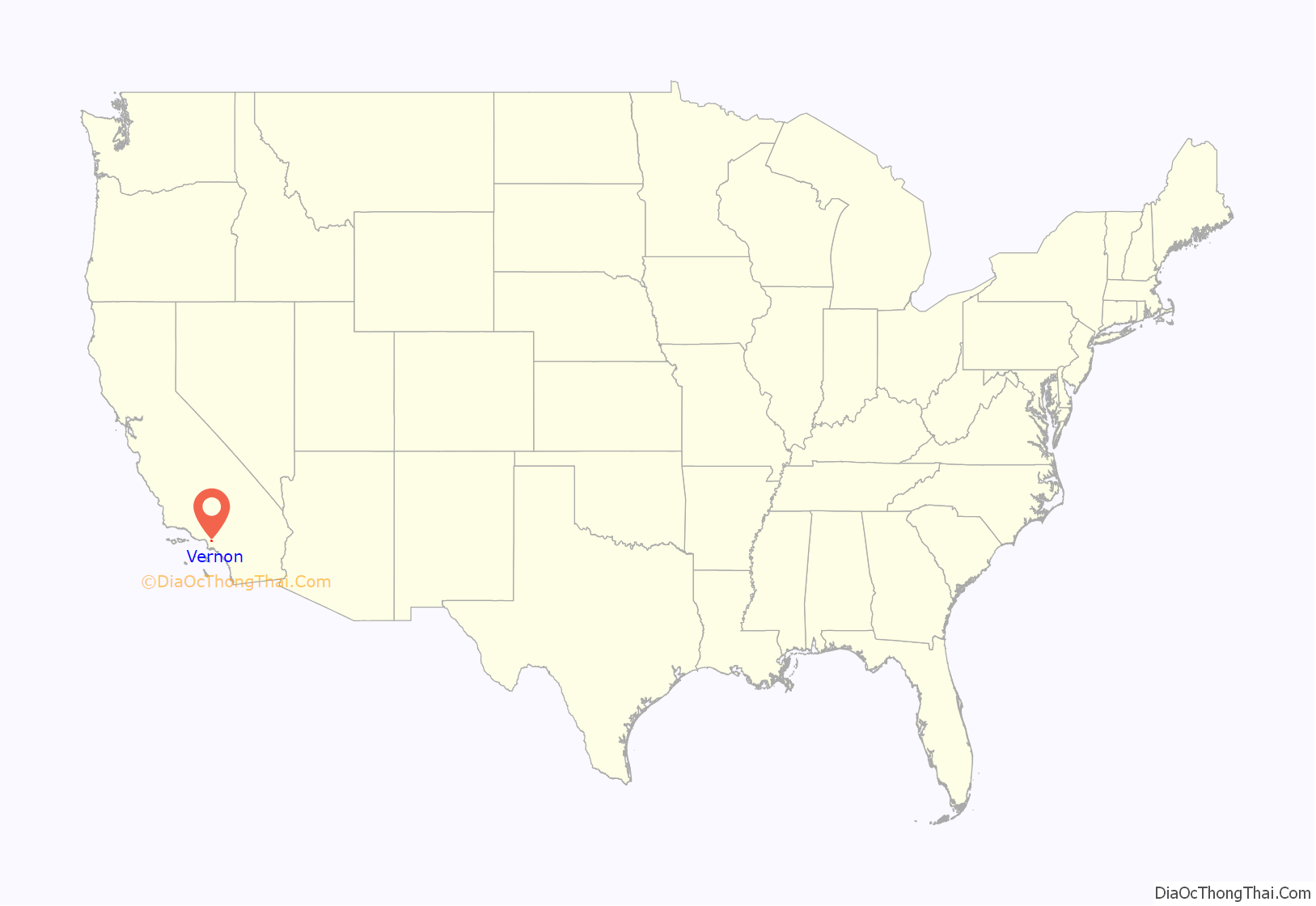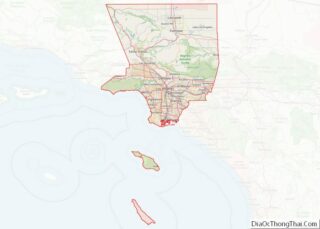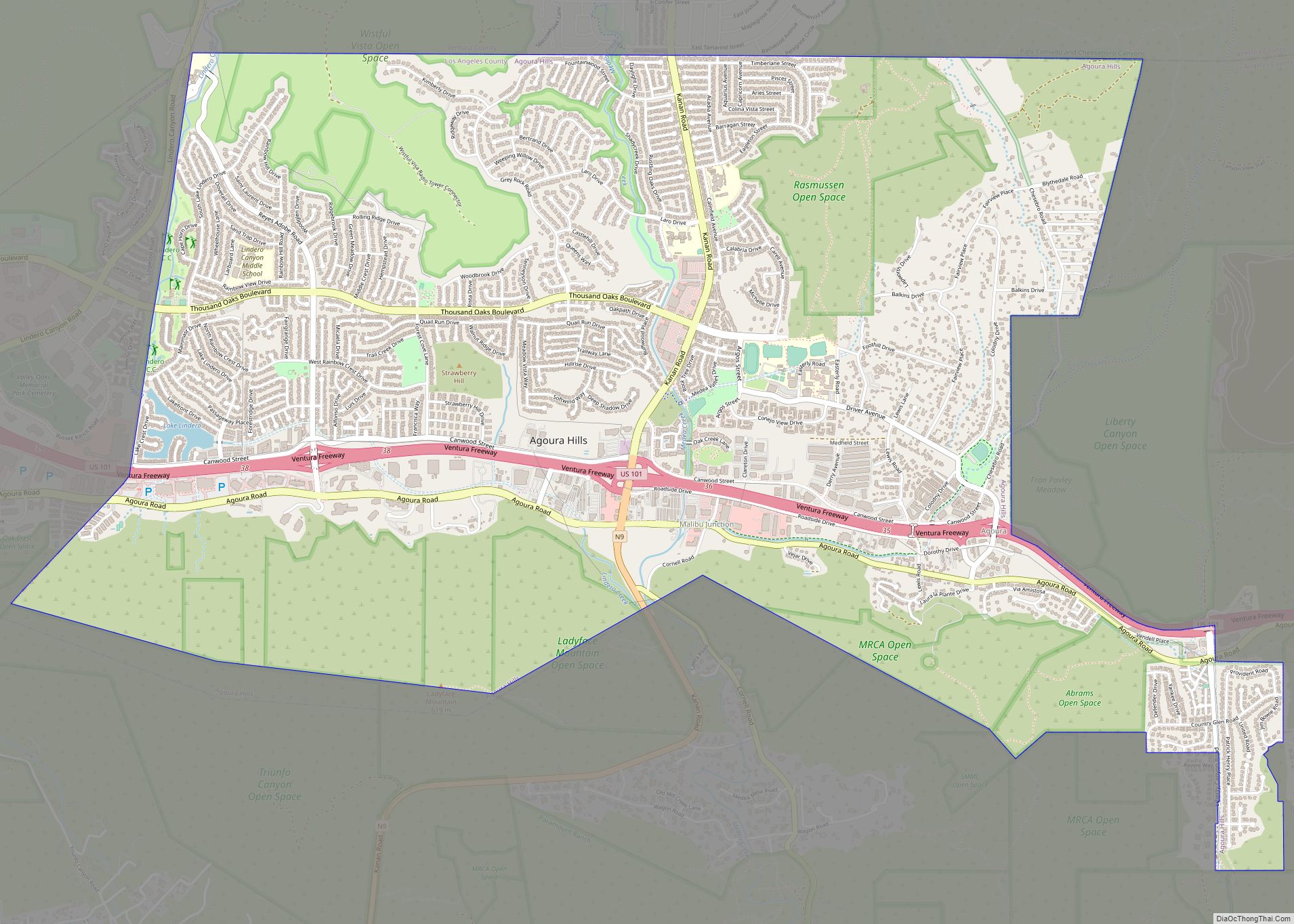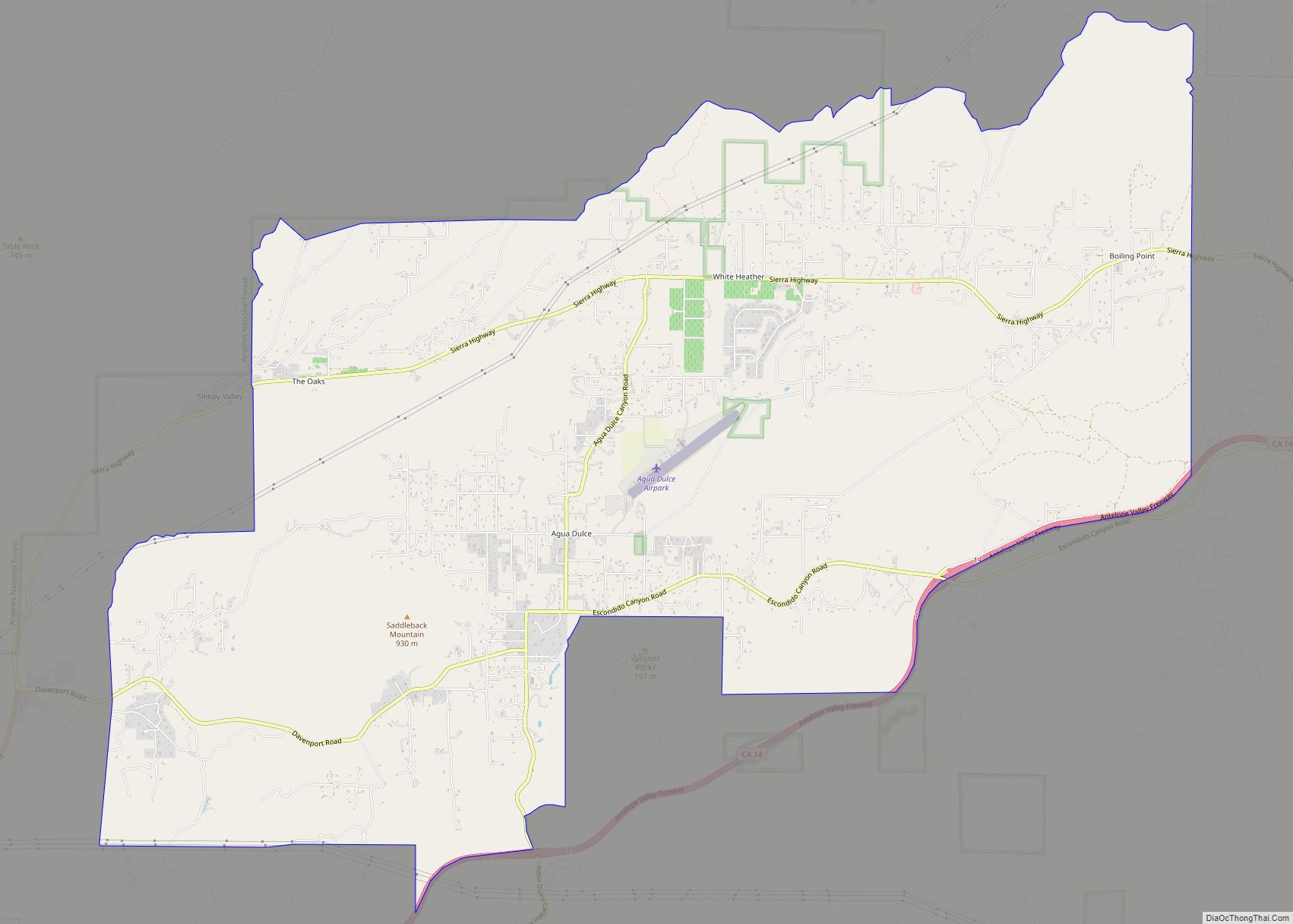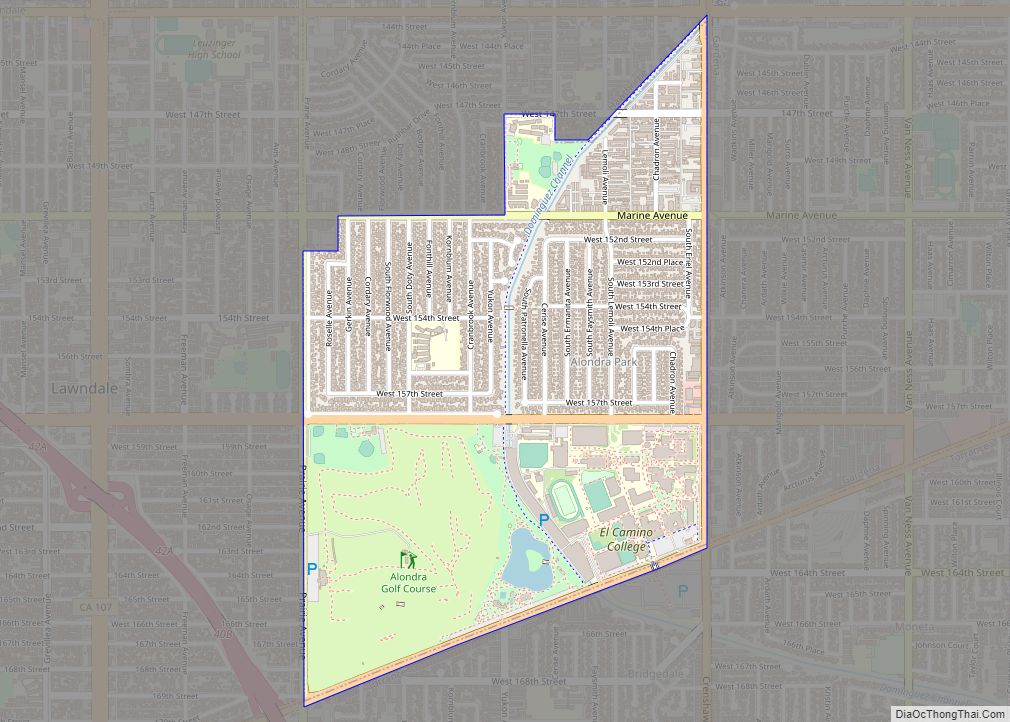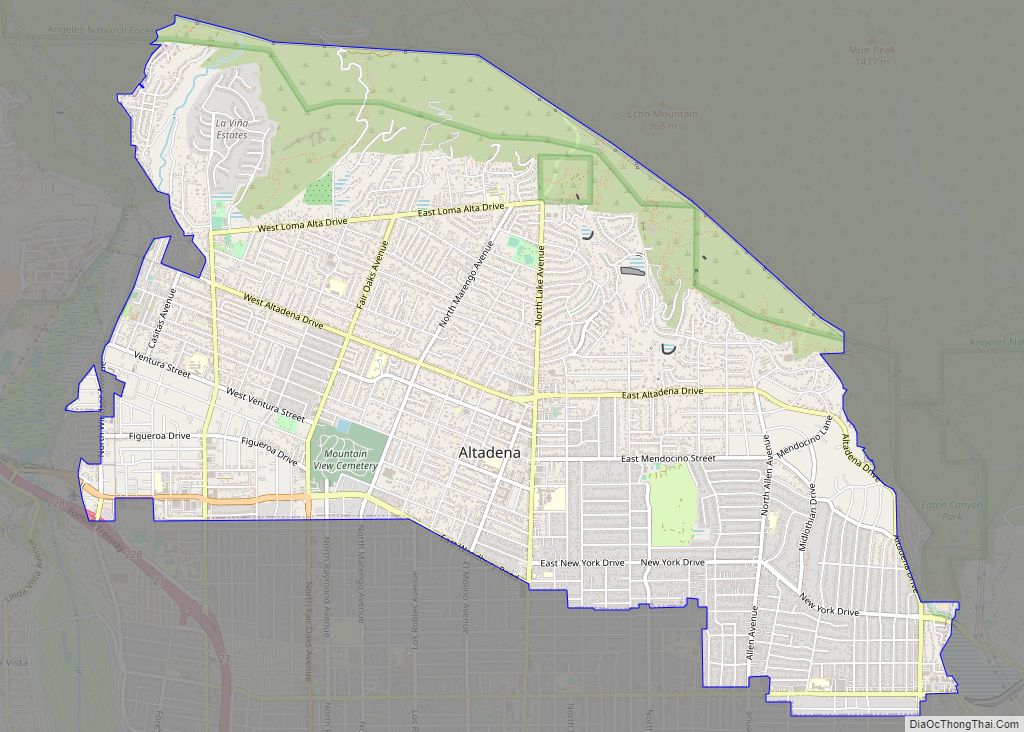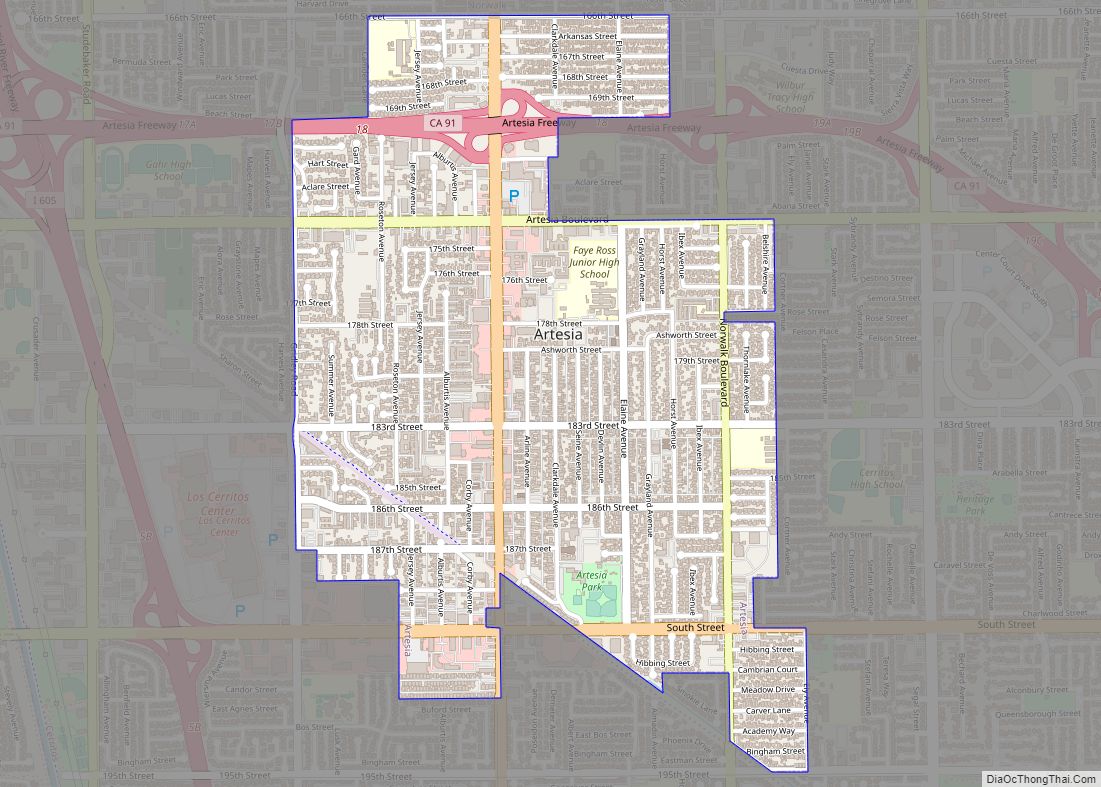Vernon is a city five miles (8.0 km) south of downtown Los Angeles, California, the nearest separate city to downtown Los Angeles. The population was 112 at the 2010 United States Census, the least of any incorporated city in the state. Its population nearly doubled to 222 by the 2020 census, making it the second least populous city in the state after Amador City, whose population grew only slightly—from 185 in the 2010 census, to 200 in the 2020 census.
The city is primarily composed of industrial areas and touts itself as “exclusively industrial”. Meatpacking plants and warehouses are common. As of 2006, there were no parks in the city.
| Name: | Vernon city |
|---|---|
| LSAD Code: | 25 |
| LSAD Description: | city (suffix) |
| State: | California |
| County: | Los Angeles County |
| Incorporated: | September 22, 1905 |
| Elevation: | 203 ft (62 m) |
| Total Area: | 5.16 sq mi (13.36 km²) |
| Land Area: | 4.97 sq mi (12.88 km²) |
| Water Area: | 0.18 sq mi (0.48 km²) 3.57% |
| Total Population: | 222 |
| Population Density: | 44.66/sq mi (17.2/km²) |
| ZIP code: | 90058 |
| Area code: | 323 |
| FIPS code: | 0682422 |
| Website: | cityofvernon.org |
Online Interactive Map
Click on ![]() to view map in "full screen" mode.
to view map in "full screen" mode.
Vernon location map. Where is Vernon city?
History
Vernon is the site of the Battle of La Mesa on January 9, 1847, when General Stephen W. Kearny again defeated General José María Flores the day after the Battle of Río San Gabriel. Accepting defeat, General Flores fled southeast to Sonora, while Major Pico headed north into the San Gabriel Mountains with a hundred Californios. This ended hostilities in Alta California during the Mexican–American War of 1846–1848. By the dawn of the 20th century, it was a stretch of unincorporated grassland near Los Angeles’ flourishing downtown.
In 1905, Vernon was incorporated by ranchers James J. and Thomas J. Furlong and John B. Leonis, a merchant. Vernon was incorporated to promote industrial development along the railroads in the area. John Leonis, of Basque origin, had come to Southern California in 1880 to work for his uncle, Miguel Leonis, and later established his own ranch on unincorporated county land southeast of downtown Los Angeles. Recognizing the importance of the three major railroads running through the area, he persuaded railroad executives to run spur tracks off the main lines and incorporated the adjacent three miles (4.8 km) as the first “exclusively industrial” city in the southwestern United States. He named the new city after a dirt road, Vernon Avenue, that crossed its center.
In 1907, on land leased from Leonis, the founders of the city marketed Vernon as a “sporting town”. Jack Doyle, an entrepreneur, opened the Vernon Avenue Arena, where 20-round world championship fights were held starting in 1908. Shortly thereafter, the Pacific Coast League built a baseball park. The Vernon Tigers, a minor league baseball team in the Pacific Coast League, played from 1909 through 1925. The team won back-to-back PCL pennants in 1919 and 1920. The ballpark also housed two 1910 Southern California Trolley League teams, the Los Angeles Maiers and the Los Angeles McCormicks.
Leonis created an enticing attraction, leasing property to the founders of the city, for a baseball stadium, a 7,000-seat boxing arena, and the “world’s longest bar”, 100 feet long with thirty-seven bartenders. As industrialists from the East Coast traveled to Vernon for heavyweight matches, Leonis sold many of them on locating their West Coast factories in Vernon. By the 1930s, Owens-Illinois and Alcoa had facilities there, purchasing subsidized electricity from the new utility Vernon Light & Power.
While some land adjacent to the original incorporated area was excluded from the city in 1910 and 1924, land to the east and south was incorporated in 1914, 1920, 1925, 1926 and 1928. The most important of these was that of 1925, when almost 800 acres of the Central Manufacturing District, which was already built up with 28 industrial plants, adding an assessed valuation of $8 million to the city’s resources. This annexation was voted up unanimously by Mr & Mrs A. J. Olsen, of 4318 S. Downey Road, the only two legal voters in the district. Such selective annexations ensured industrial areas were brought within the city, while residential areas were excluded.
The Studebaker factory was built in 1938 at 4530 Loma Vista Avenue. It was the company’s only West Coast factory, producing 64 cars a day. It was closed in 1956, and ten years later in 1966, Studebaker folded. It is now the location of St. Regis Paper.
Following Leonis’ death in 1953, he left behind an estate reportedly worth $8 million, as well as several parcels of land, to his grandson Leonis. Leonis Malburg first won a council seat in 1956 and was elected mayor in 1974. “Vernon has long been dogged by accusations that it is a fiefdom run by a family that has held sway over the town for generations.”
The Poxon China Company was founded by George Wade Poxon (b. 1887, Castle Donington, Leicestershire, England) and his wife Judith (née Furlong), who in 1913 were married at St. Martha’s Church in Vernon. The church had been built by the Furlong family in 1913. George Wade Poxon, a cousin of George Albert Wade (later Colonel Sir George Albert Wade), was well known as the chairman of Wade Potteries Limited in England, which produced Wade Whimsies. George Wade (b. about 1863 Tunstall, Staffordshire, father to George Albert Wade and uncle to George Wade Poxon) owned a pottery in Burslem, Staffordshire, England. The Wade family had been associated with the pottery industry for many years. George Wade Poxon was a member of the Royal Science Academy. At the age of 24, in 1911, he emigrated to the United States. The kilns were located on the Furlong ranch.
Vernon Kilns was founded in July 1931 after Faye G. Bennison purchased the Poxon China Company in Vernon. The Poxon China Company had its headquarters on 52nd Street, which is now part of Los Angeles. Bennison continued to produce Poxon lines, using Poxon shapes until an earthquake in 1933 forced Bennison to develop new and original shapes for the company. Two fires in the late 1940s almost destroyed Vernon Potteries, Ltd., but Bennison rebuilt and the company continued to thrive. The company was not able to compete when foreign imports flooded the US. In 1958 Vernon Kilns sold all its holdings to Metlox. Metlox continued to market some Vernon shapes and patterns under the division Vernonware until 1989. The company produced dinnerware, art pottery, figurines, ashtrays and other popular items. All products were of earthenware, with clays from Tennessee, Kentucky, North Carolina, and England. Glazes were developed from minerals mined in California, and many patterns, including all of the plaids, were hand painted.
Vernon returned to being exclusively industrial around 1919. Two giant stockyards were opened and meat packing quickly became the city’s main industry. Twenty-seven slaughterhouses eventually lined Vernon Avenue from Soto Street to Downey Road until the late 1960s.
The 1940s and 1950s added aerospace contractors Norris Industries, box and paper manufacturers, drug companies such as Brunswig, and food processors General Mills and Kal Kan. Giant meat packers Farmer John and Swift flourished.
In 1932, after a dispute with Southern California Edison over industrial rates for electricity, John Leonis sponsored a bond measure to authorize the building of a city-owned power plant, which is still operational today, providing the city with its notably lower utility rate.
Elections of 2006
The city held no contested or meaningfully competitive elections from 1980 to 2006. Out of five city council members serving at in 2006, only one had been chosen by the voters, the other four having been appointed to their positions by city officials.
Most of the city’s fewer than 90 voters are city employees or connected to city employees who live in homes rented at a nominal fee. In 1979 a firefighter tried to run for mayor and was immediately evicted and told he couldn’t run. In 2006 a group of outsiders tried to move into Vernon to run for office. The city tried to cancel their registrations but was ordered to allow them to run and to count the ballots. Almost none of the city employees voted for them. Leonis C. Malburg, the mayor for fifty years, was convicted of voter fraud, conspiracy, and perjury in December 2009. In May 2011, former city administrator Bruce Malkenhorst Sr. accepted a plea deal for misappropriating $60,000 in public funds.
In 2006, a controversy arose concerning a few people who moved into Vernon and ran for city council, the first time in more than two decades that there was a competitive race for city council. In 2006, eight people converted a 1950s-era office building into a five-room apartment (the building had previously been used as a tanning facility turning sheepskin into billiard/pool pockets), and three of them filed to run for office. In response, the city turned off their power and attempted to evict them as illegal squatters. The City of Vernon alleged that the men were part of a hostile takeover attempt by convicted felon Albert T. Robles, who nearly bankrupted the nearby city of South Gate as treasurer, and Eduardo Olivo, a former Vernon attorney who also worked with Albert T. Robles in South Gate.
On June 30, California Secretary of State Bruce McPherson called on the city to count the votes and expressed his support for the state to take over the responsibility of conducting the city’s elections. During the trial it was alleged that all three of the newcomer candidates had direct ties to Albert T. Robles: Alejandro Lopez is a first cousin, David Johnson Jr. is the brother-in-law of a business partner, and Don A. Huff is associated through Eduardo Olivo. In March 2006, Judge David P. Yaffe ruled that the city could not prohibit legally registered voters who reside within its boundaries from running for city council. The city had to be ordered to allow the election to proceed. An election was held under a court order on April 11, 2006. But the city clerk, Bruce Malkenhorst Jr., refused to count the ballots until the legal disputes were resolved, and temporarily ordered the ballots to be sealed. In August 2006, Los Angeles Superior Court Judge Aurelio Munoz ruled that the newcomers received free rent and jobs prior to registering to vote and that they were involved in a scheme orchestrated by Albert T. Robles and Eduardo Olivo to “steal” the election, but that such actions were not illegal. On October 16, 2006, it was announced that city officials were ready to count the votes from the contested April 11 election. The officials failed to prove their claim of voter fraud. A judge granted Vernon’s motion to count the votes. The challengers lost by a landslide.
Corruption
On November 15, 2006, the investigation into alleged public corruption in Vernon resulted in charges against the city’s mayor, Leonis Malburg, as well as his wife, his son, and the former city administrator. The Los Angeles District Attorney’s office had launched an investigation in April 2005 upon allegations that the city’s former administrator, Bruce Malkenhorst Sr., had misappropriated public funds for personal use.
Their investigation uncovered evidence of voter fraud on the part of the ruling family, which, it was asserted, tried to keep out new residents. Leonis Malburg, who has been mayor for 50 years, claimed he lived in a small Vernon apartment in the 2800 block of Leonis Boulevard (named after his grandfather, also a mayor), when in fact he was living in upscale Hancock Park, Los Angeles. His wife and son also claimed to live in Vernon, voting in Vernon elections although evidence indicated they too lived in Hancock Park. Charges against the Malburgs included voter fraud, assisting unqualified voters, false registration, and perjury.
Malkenhorst Sr. was charged with 18 counts of “misappropriation of public funds” for reportedly taking $60,000 of city money for personal use. His salary from the city had been $600,000. Malkenhorst at one time collected a pension of $499,674.84. In 2010, Malkenhorst received a reported $510,000 annual pension, plus health benefits, as former city administrator, the most of any of the 9,111 retired California government workers receiving pensions from CalPERS. Malkenhorst retired in 2005.
“With longstanding political woes, Vernon faced allegations of corruption similar to those in nearby cities such as the City of Bell. Although Vernon and Bell share a border in Southeast Los Angeles County, they are very different cities. Bell is a working-class, largely immigrant city with 38,000 residents. Vernon has fewer than 100 residents and is largely a business and industrial hub.” Vernon’s city official salaries once rivaled those of the City of Bell.
Expanding legal action against excessive salaries and pensions in two southeast Los Angeles County cities, (then) Attorney General Jerry Brown had subpoenaed testimony from the City of Vernon. Brown’s subpoena sought testimony under oath from Vernon officials about compensation and pension benefits for six highly paid city officials, one of whom received more than $1.6 million in a single year from the city.
According to media reports and other sources, former Vernon city administrator Eric T. Fresch was paid $1.65 million in 2008. In 2009 O’Callaghan was paid $785,000, Burnett, $570,000, and Harrison, $800,000. Malkenhorst Jr. was paid $290,000 in 2008. Malkenhorst Sr., who also has been charged with misappropriation of public funds, retired in 2005, and as a former employee, still receives a pension that is the highest in the state of California. Malkenhorst Sr. has been convicted of fraud and is under investigation for several other charges. Malkenhorst pleaded guilty in May 2011 to illegally using public money to pay for personal items. Prosecutors said that from 2000 to 2005, he was illegally reimbursed for personal expenses that included meals, golfing, massages, a personal trainer, and a home security system. He received three years’ probation and was fined $35,000, including penalties. He was ordered to repay $60,000 in restitution. He was fined $10,000 in addition to other penalties. His total of $105,000 in fines will be no problem for Malkenhurst, who continues to receive the highest public pension in California: $509,664. “The law states that pensions are revoked if an elected official is convicted of a felony, but not in the case of an employee,” said Brad Pacheco, a spokesman for CalPERS. Malkenhorst “would continue to receive his pension according to the law.”
In September 2010, the Los Angeles Times reported that the inquiry followed the newspaper’s report that Donal O’Callaghan, then city administrator, received $243,898 in consulting payments through June 2010, through Tara Energy, Inc., the company run by his wife, Kimberly McBride. The payments were in addition to O’Callaghan’s yearly salary of $380,000. He was accused of corruption for his role in obtaining city jobs for his wife. O’Callaghan was indicted by a Los Angeles grand jury on three felony counts of conflict of interest and misappropriation of public funds. He pleaded not guilty to two felony counts of conflict of interest involving contracts and one of public officer crime.
The Los Angeles Times reported that Eric Fresch, who now serves as a legal consultant, has been paid over $1 million for the last four years. He was paid almost $1.65 million in salary and hourly billings in 2008, when he was serving as both city administrator and deputy city attorney. Others in Vernon received $570,000 to $800,000 in 2009. Former City Attorney Jeffrey A. Harrison earned $800,000 in 2009, and City Treasurer/Finance Director Roirdan Burnett made $570,000. In 2008, Harrison was paid $1.04 million.
In 2010, Malburg, the former mayor for fifty years, was ordered to pay more than $500,000 after being found guilty of fraud. Prosecutors stated he claimed to live in Vernon but actually had a home in the wealthy Hancock Park area of Los Angeles. Leonis Malburg and his wife, Dominica, were convicted of voter fraud and other charges.
State Senator Tony Strickland (R-Moorpark) proposed a bill that would divest the pensions of any public official convicted of abusing public funds. The bill, SB115, was killed in a state Senate committee. The bill drew the ire of several employee groups, including the AFL–CIO, the California Professional Firefighters, and the California State Employees Association. These groups and the lawmakers who voted against the bill contended that “it discriminated against public employees relative to private employees and said such a law would really harm the innocent spouse and family of the convicted officer, who will lose their financial security.” Strickland stated he was “shocked” that the bill was killed. “State law affects judges and elected officials, but not people like Rizzo,” he said. “The argument about the family is a weak argument that can apply to any person convicted of a crime. Families are always affected when you talk about criminals.”
Disincorporation legislation
Vernon has dealt with the idea of disincorporation after city government corruption was discovered. In 2011, legislation was being considered to move to disincorporate the city. If this had taken effect, Vernon would be the third incorporated place to be disbanded in the past forty years, after Cabazon in 1972 and Hornitos in 1973. California State Assemblyman John Pérez submitted a bill to the California legislature which would have disincorporated Vernon as a city. The allegations of rampant corruption prompted the state Assembly to approve Pérez’s proposed legislation, AB46, to disincorporate cities with fewer than 150 residents. Vernon is the only city that would have been affected by the bill.
According to an editorial in the April 26, 2011, edition of the Long Beach Press-Telegram, support to maintain Vernon’s city status came from two powerful groups that were rarely allied: The business community (including the California, Los Angeles, and Vernon chambers of commerce) and the labor community (including the Los Angeles Federation of Labor and the Teamsters) joined in the battle against Sacramento. Both groups acknowledged that Vernon needed a comprehensive political housecleaning, but both maintained its right to cityhood. Gloria Molina, a member of the Los Angeles County Board of Supervisors, which has voted in support of disincorporating Vernon, stated: It is a “company town masquerading as a city.” “The city has been a facade for some personal gain issues. The residents are employees of the city or major companies and consequently are controlled.” If the bill becomes law, Los Angeles County could and most certainly would absorb Vernon.
The bill had passed in the Assembly on a bipartisan vote of 58–7.
In the last few weeks of the legislative session of summer 2011, a team of attorneys and lobbyists from Vernon were trying to kill the bill that would disincorporate the city when state Senator Kevin de Leon (D-Los Angeles) came to them with a creative and unconventional offer. De Leon, who had earlier supported disbanding Vernon, said he would help to defeat the legislation if Vernon would accept a proposed list of government reforms and set aside $60 million in order to fund community projects in the small, working-class cities that surround Vernon. Vernon agreed to the offer, and de Leon then proceeded to support the groups fighting disincorporation. City officials in nearby Huntington Park, which stood to receive some of Vernon’s grant money, also reversed their support to the City of Vernon. On August 29, the state Senate rejected the bill to disband Vernon.
The Vernon City Council unanimously passed salary limits and other wide-ranging reforms on May 26, 2011, as the tiny Los Angeles suburb fought efforts to eliminate its cityhood. The council approved an amended package that cut the salaries of council members from $70,000 to $25,000 a year, but not beginning until the end of their current terms. Other officials, including the police chief, also will saw their salaries trimmed. Department heads’ salaries were capped at $267,000. Previously, some city officials allegedly made more than $1 million to govern the city. The council also authorized benefit reductions for officials, established a city housing commission, and voted to place a proposal on the city ballot that would change the city charter and limit council members to two, five-year terms. The city owns nearly all residential housing in town and there had been concerns that its officials were de facto landlords of the voters.
The reforms took the city of Vernon further toward a more open, transparent and inclusive governance structure,” MacFarlane said. “The business community will have a role to play, as will representatives of labor, and those are two key constituencies.” On August 2, 2011, former state attorney general John Van de Kamp, hired by the city to do an independent review of its policies, released a report that found “no significant fault” in Vernon’s compliance with the Political Reform Act, conflict of interest policies, the Brown Act, or the Public Records Act.
Transparency and progress
In an effort to modernize the city and stave off the potential threat of disincorporation in the future, for the first time in the city’s history Vernon opened its doors to new residents from the general public. In 2015, Vernon’s population nearly doubled with the opening of Vernon Village Park Apartments on E. 52nd Drive and King Avenue, the majority of which were made available to the public and not exclusively to those affiliated with Vernon industry and city government, as had been the case for most of the city’s history. In effect, this means that the democratic process in Vernon can no longer be a carefully managed internal affair used to keep already influential individuals in power, a major adjustment in its own right.
Facing significant revenue shortfalls, in 2017 the Vernon city government proposed “Measure Q” to voters, which would have generated additional revenue to fund the government via a tax increase on electricity generated and sold by the city to residents and industries. Vernon residents rejected the tax increase by a margin of nine votes, with 23 voting no, and only 14 voting in favor of the utility tax increase.
Vernon’s City Council is composed of five members, each elected to a five-year term according to the city’s charter. Voters elect one City Council member during the city’s April municipal elections, which take place on a second Tuesday. Vernon is one of the cities opposed to California’s Senate Bill 415, which prohibits stand-alone elections for city councils, K–12 public schools, community colleges, and special districts, consolidating them with even-year county, state, and federal primary and general elections.
Vernon Road Map
Vernon city Satellite Map
Geography
According to the United States Census Bureau, the city has a total area of 5.2 sq mi (13.5 km). 5.0 sq mi (12.9 km) of it is land and 0.2 sq mi (0.5 km) (3.57%) of it is water.
See also
Map of California State and its subdivision:- Alameda
- Alpine
- Amador
- Butte
- Calaveras
- Colusa
- Contra Costa
- Del Norte
- El Dorado
- Fresno
- Glenn
- Humboldt
- Imperial
- Inyo
- Kern
- Kings
- Lake
- Lassen
- Los Angeles
- Madera
- Marin
- Mariposa
- Mendocino
- Merced
- Modoc
- Mono
- Monterey
- Napa
- Nevada
- Orange
- Placer
- Plumas
- Riverside
- Sacramento
- San Benito
- San Bernardino
- San Diego
- San Francisco
- San Joaquin
- San Luis Obispo
- San Mateo
- Santa Barbara
- Santa Clara
- Santa Cruz
- Shasta
- Sierra
- Siskiyou
- Solano
- Sonoma
- Stanislaus
- Sutter
- Tehama
- Trinity
- Tulare
- Tuolumne
- Ventura
- Yolo
- Yuba
- Alabama
- Alaska
- Arizona
- Arkansas
- California
- Colorado
- Connecticut
- Delaware
- District of Columbia
- Florida
- Georgia
- Hawaii
- Idaho
- Illinois
- Indiana
- Iowa
- Kansas
- Kentucky
- Louisiana
- Maine
- Maryland
- Massachusetts
- Michigan
- Minnesota
- Mississippi
- Missouri
- Montana
- Nebraska
- Nevada
- New Hampshire
- New Jersey
- New Mexico
- New York
- North Carolina
- North Dakota
- Ohio
- Oklahoma
- Oregon
- Pennsylvania
- Rhode Island
- South Carolina
- South Dakota
- Tennessee
- Texas
- Utah
- Vermont
- Virginia
- Washington
- West Virginia
- Wisconsin
- Wyoming
